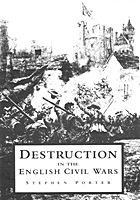Stephen Porter, "Destruction in the English Civil Wars", Alan Sutton, 1994,180 pp. maps, illus., bibliography. £17.99
The author is an assistant editor with the Royal Commission for Historic Monuments, and this book is partly a product of his work there and as a reserach assistant to a number of leading 17th century historians, including Ian Roy. As a result of this, Stephen Porter has gained extensive knowledge of the contents of Britain's record repositories, whose sources he puts to excellent use in this pioneering study.

Large Version of Cover Art (137K)
The destructive material effects of the Civil Wars in England and Wales, the subject of this book, are brought home by the author's estimates that by the end of 1648, about 150 towns, and probably at least the same number of villages had suffered severe damage, 200 country houses had been destroyed, and 50,000 people rendered homeless.
In his opening chapter, Mr. Porter sets the destruction of the English Civil Wars in their contemporary European context. He outlines the increasingly destructive effects of changing styles of warfare on civilian life, and points out the influence of the large number of British and foreign veterans of Continental warfare on the fighting in Britain.
"The Causes of Destruction" analyses the methods by which towns and cities were fortified, and the associated destruction of suburbs, etc which this entailed. A wealth of examples are given, and the wide range of topics covered include local strongholds and the effects of these on the surrounding populations.
In "Methods and Limitations", the methods of siege warfare are discussed, together with their impact on the civilian population. Among the many interesting points brought out is the fact that many so-called "demolished" buildings were in fact carefully dismantled, and either re-erected, stored, or their materials used to strengthen the fortifications.
Also discussed are the various weapons used by both defenders and besiegers, including artillery, mortars, fire arrows, fire pikes and fireships. The author points out that in fact most siege bombardments were of fairly low intensity, giving some interesting statistics. He also analyses the social and econmomic considerations which often limited the degree of destruction carried out by both sides.
Later chapters discuss the extent of the destruction suffered during the wars, using the evidence of surveys carried out, especially at the end of the war, when Parliament set up the "Committee for Burning" to assess the damage. Though Porter produces some estimates of the numbers of towns and villages badly affected, he agrees that the sources available make such figures likely to be incomplete and unreliable. Regional surveys are included, which help emphasise that small, indefensible towns, which were primarily useful for billeting and revenue purposes, were much more likely to escape serious destruction than larger centres of strategic importance. Not surprisingly, he concludes that the greatest amount of destruction occured during the last two years of the First Civil
In his chapter dealing with recovery and rebuilding, the author discusses the sources of finance for this, pointing out that during the Commonweatlth period, pro- Royalist areas generally came off badly. Interesting details are given of the methods adopted for removing earthworks and siegeworks. The final chapter of the book covers the legacy of the war - some towns having of still not recovered by the early 18th century. Permanant casualties included many castles and country houses, and some churches, many survivors being rebuilt in different styles. The longer term effects on social and economic geography are also discussed.
The book concludes with a useful gazeteer of selected relevant towns and buildings, where evidence may still be seen.
This is a first rate and invaluable study of a hitherto neglected area, readable, and supplemented by excellent illustrations, which will be of equal value to military, economic and social historians, and others more generally interested. Recommended.
Back to English Civil War Notes & Queries No. 50 Table of Contents
Back to English Civil War Times List of Issues
Back to Master Magazine List
© Copyright 1994 by Partizan Press
This article appears in MagWeb (Magazine Web) on the Internet World Wide Web.
Other military history articles and gaming articles are available at http://www.magweb.com